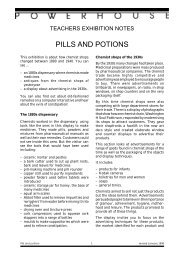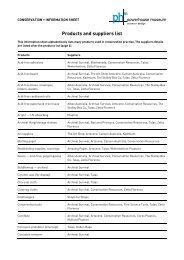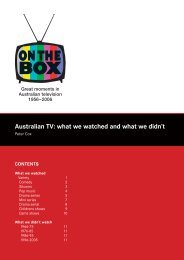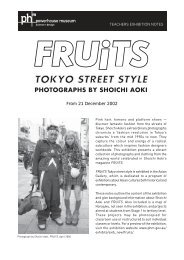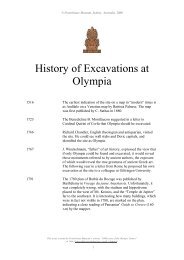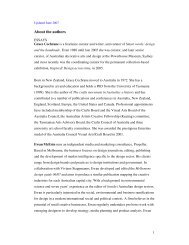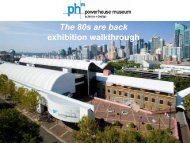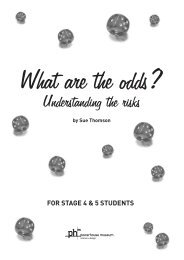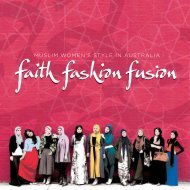+the magazine of the powerhouse museum summer 04/05
+the magazine of the powerhouse museum summer 04/05
+the magazine of the powerhouse museum summer 04/05
Create successful ePaper yourself
Turn your PDF publications into a flip-book with our unique Google optimized e-Paper software.
+ 16 powerline <strong>summer</strong> <strong>04</strong>/<strong>05</strong><br />
DR NICHOLAS G PAPPAS, PRESIDENT OF THE BOARD OF<br />
TRUSTEES, REFLECTS ON OUR 125TH ANNIVERSARY AND<br />
THE ‘WORLDWIDE INTELLECTUAL TRADITION’ OF MUSEUMS.*<br />
celebration <strong>of</strong> <strong>the</strong> earthly<br />
The Powerhouse Museum’s reputation as an<br />
Australian cultural institution <strong>of</strong> <strong>the</strong> highest calibre<br />
has grown over 125 years — from a multi-faceted and<br />
rich entity born out <strong>of</strong> <strong>the</strong> ashes <strong>of</strong> <strong>the</strong> Garden<br />
Palace in <strong>the</strong> Botanic Gardens to its present home<br />
within <strong>the</strong> magnificent shell <strong>of</strong> <strong>the</strong> Ultimo Power<br />
Station.<br />
In <strong>the</strong> 18th and 19th centuries, <strong>museum</strong>s were<br />
designed deliberately to resemble older ceremonial<br />
monuments, such as palaces or temples. The<br />
decision to install <strong>the</strong> early predecessor <strong>of</strong> <strong>the</strong><br />
Powerhouse, <strong>the</strong> elegantly named Technological,<br />
Industrial and Sanitary Museum, in <strong>the</strong> Garden Palace<br />
was based on such a premise. A <strong>museum</strong> had to look<br />
like a <strong>museum</strong>, and classical adornments were<br />
considered essential.<br />
It could be argued that <strong>the</strong> fondness for heavy Greek<br />
pediments and entablatures harked back to a more<br />
pagan appearance, so that <strong>the</strong> post-Enlightenment<br />
dichotomy between Church and State could be<br />
publicly reinforced. The underlying message was that<br />
<strong>museum</strong>s were closer to <strong>the</strong> questioning and less<br />
inhibited world <strong>of</strong> <strong>the</strong> ancients, ra<strong>the</strong>r than to <strong>the</strong><br />
narrower moral confines <strong>of</strong> pre-Enlightenment<br />
Europe.<br />
However, <strong>the</strong> origins <strong>of</strong> such liberal attitudes came<br />
many centuries before: <strong>the</strong> famous Museum <strong>of</strong><br />
Alexandria, which flourished for over 600 years, was<br />
<strong>the</strong> first symbol <strong>of</strong> a pagan yearning for <strong>the</strong><br />
systematic collection, organisation and preservation<br />
celebrating 125 years<br />
<strong>of</strong> knowledge. Closer to <strong>the</strong> modern university, it was<br />
<strong>the</strong> first attempt to establish a ‘worldwide’ (in <strong>the</strong><br />
sense <strong>of</strong> those times) intellectual tradition. Long<br />
before <strong>museum</strong>s became places where <strong>the</strong> ritual <strong>of</strong><br />
nation-building was practised (as in <strong>the</strong> great colonial<br />
<strong>museum</strong>s <strong>of</strong> <strong>the</strong> 19th century), <strong>the</strong> Museum <strong>of</strong><br />
Alexandria had developed into an independent,<br />
abundantly secular place <strong>of</strong> learning that, in turn,<br />
spawned great research centres throughout <strong>the</strong> Near<br />
East and beyond after <strong>the</strong> 7th century.<br />
It is a sad fact, and today a touch ironic, that cities<br />
like Baghdad and Beirut — which feature in our<br />
current exhibition Beirut to Baghdad: communities,<br />
collecting and culture and could trace <strong>the</strong>ir cultural<br />
enlightenment to Alexandria — were for so many<br />
centuries names emblematic <strong>of</strong> high learning, while<br />
western Europe was floundering upon its own<br />
religious divisions and cultural inwardness.<br />
Which brings me back to <strong>the</strong> Powerhouse Museum. If<br />
one word suitably describes this institution's qualities,<br />
it is its ‘secularism’. This is a <strong>museum</strong> in <strong>the</strong> tradition<br />
<strong>of</strong> <strong>the</strong> Museum <strong>of</strong> Alexandria. It is a celebration <strong>of</strong> <strong>the</strong><br />
earthly, <strong>of</strong> <strong>the</strong> temporal, even occasionally <strong>of</strong> <strong>the</strong><br />
pr<strong>of</strong>ane. Nestled as it is in <strong>the</strong> vast embrace <strong>of</strong> a<br />
disused power station — what grander symbol could<br />
<strong>the</strong>re be <strong>of</strong> <strong>the</strong> Powerhouse's earthliness — <strong>the</strong><br />
Powerhouse is a place where <strong>the</strong> indomitable human<br />
spirit to improve his or her lot is exalted on a lay altar.<br />
It makes <strong>the</strong> Powerhouse, I suggest, a truly<br />
international <strong>museum</strong>, a place that uniquely<br />
succeeds in attracting multiple and separate<br />
audiences and <strong>the</strong>reby transcends narrow cultural or<br />
artistic boundaries.<br />
This became most apparent to me only some three<br />
months ago. On 1 July this year, I was privileged to<br />
represent <strong>the</strong> Powerhouse at <strong>the</strong> opening in A<strong>the</strong>ns<br />
<strong>of</strong> our exhibition Our Place: Indigenous Australia now,<br />
Australia's <strong>of</strong>ficial gift to <strong>the</strong> Cultural Olympiad<br />
program <strong>of</strong> <strong>the</strong> 20<strong>04</strong> A<strong>the</strong>ns Olympic Games. Here<br />
was an exhibition that dealt openly and honestly<br />
about contemporary Indigenous culture and about<br />
some <strong>of</strong> <strong>the</strong> more unsavoury chapters in relations<br />
between <strong>the</strong> European and Indigenous communities,<br />
experiences that have shaped and informed <strong>the</strong><br />
Indigenous community's significant cultural output.<br />
The international audience that viewed <strong>the</strong> exhibition<br />
that opening night in A<strong>the</strong>ns was struck by its<br />
honesty and by its sense <strong>of</strong> robust independence. On<br />
that night, I felt very much that <strong>the</strong> Powerhouse had<br />
come <strong>of</strong> age internationally by proclaiming beyond<br />
Australia's own shores our nation's pride in <strong>the</strong><br />
cultural traditions and achievements <strong>of</strong> its Indigenous<br />
communities. I also sensed that night from <strong>the</strong><br />
reactions <strong>of</strong> those present that <strong>the</strong> Powerhouse had<br />
become an acknowledged part <strong>of</strong> that ‘worldwide<br />
intellectual tradition’, which was first inspired by <strong>the</strong><br />
Museum <strong>of</strong> Alexandria so many centuries ago.<br />
And so we look ahead hopefully to ano<strong>the</strong>r 125 years<br />
<strong>of</strong> growth and prosperity. Yes, <strong>the</strong>re will be<br />
challenges. But <strong>the</strong> future is bright for <strong>the</strong><br />
Powerhouse Museum.<br />
* This is an edited version <strong>of</strong> Dr Pappas’ speech to <strong>the</strong> Life Fellows Dinner<br />
on 23 September 20<strong>04</strong>.<br />
FROM LEFT: POWERHOUSE MUSEUM PRESIDENT DR NICHOLAS PAPPAS, HER EXCELLENCY PROFESSOR MARIE BASHIR, GOVERNOR OF NSW, AND MUSEUM DIRECTOR DR KEVIN FEWSTER. PAUL DYER, ARTISTIC DIRECTOR OF<br />
THE AUSTRALIAN BRANDENBURG ORCHESTRA, AND DR KEVIN FEWSTER. DISTINGUISHED SERVICE AWARD RECIPIENT JANE DE TELIGA WITH RAE DE TELIGA AND MUSEUM TRUSTEE ANDREW DENTON. MARLENE KERR AND<br />
DENIS KERR, DEPUTY MANAGING DIRECTOR SHARP AUSTRALIA ON THE GARDEN PALACE PROMENADE. DAVID TERRAZAS, NATIONAL PRESIDENT, AUSTRALIAN GRAPHIC DESIGN ASSOCIATION, AND JUDY DONE. PHOTOS BY<br />
MARINCO KOJDANOVSKI.<br />
OPPOSITE: THE GARDEN PALACE PROMENADE, SPECIALLY CREATED FOR THE 125TH ANNIVERSARY, WAS A LIVING LINK WITH THE MUSEUM’S ORIGINAL SITE. THE 1890S TERRACOTTA STATUE BY DOULTON IS ONE OF A PAIR,<br />
GIFT OF LEO SCHOFIELD. THE STONE COLUMNS FORMED PART OF THE EARLY MUSEUM’S ECONOMIC GEOLOGY DISPLAY. PHOTO BY SUE STAFFORD.



